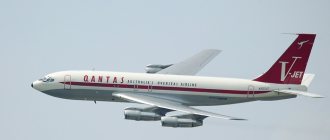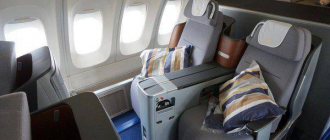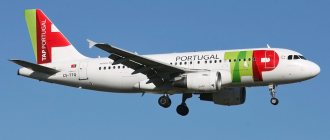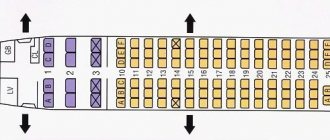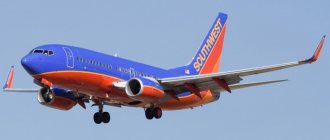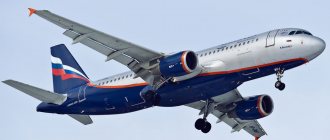| Technical specifications Interior diagrams Passenger reviews |
The Boeing 767–300 is a wide-body aircraft designed for long-haul and medium-haul flights. Produced by the American corporation The Boeing Company since 1981. In Russia, these liners are mainly used on charter flights departing to foreign resorts: Thailand, Vietnam, India (primarily Goa), Dominican Republic, etc.
Previously, Boeing 767-300 were used on regular international flights from Russia, but in 2014 - 2015, the airlines Aeroflot and Rossiya took them out of service.
Meanwhile, the Boeing 767-300 and its modifications continue to be used by such large foreign airlines as Delta Air Lines, Austrian Airlines, Air Canada, American Airlines, Air New Zealand, British Airways.
Boeing 767 versions
- 200. Basic model, the development of which began back in 1978 (i.e. 4 years before the start of operation). The maximum number of passengers was 255 seats, and the cabin was divided into 3 classes. Only 128 aircraft of this model were produced. Currently out of production.
- 200ER. An improved version of the previous model. The main innovation is the increased flight range. This is the first model in this family on which it became possible to fly across the Atlantic. In 1984, EI AI began operating the 200ER. In 1988, a flight range record for aircraft of this type was set - 16,160 km. A total of 121 aircraft of this model were manufactured.
- 300. It differs from the previous model in its fuselage increased by 6.5 meters. Its production began in 1983, and the first company to begin operation was Japan Airlines (1986). A total of 104 aircraft of this brand were created.
- 300ER. An improved model, featuring an increased flight range, passenger capacity and an improved engine. To date, more than 500 aircraft have been produced. The 300ER is the most popular model of its family.
- 300F. A highly specialized model designed exclusively for cargo transportation. A total of 88 aircraft left the factory.
- 400ER. The most advanced model in the line, with increased dimensions (the fuselage is 6.43 m longer and the wingspan is 4.36 m longer). Key innovations: updated interior, more powerful engine, modern computer equipment for controlling the car. A total of 37 units of this model were produced.
Location and classification of the cabin
The Boeing 767 aircraft cabin has a capacity of 181 to 375 people (depending on modification). Passenger seats are divided into 2 categories: economy and business class.
Economy class
Occupies seats numbered 6 to 39. This part of the cabin has 2 aisles, the seats are arranged in a 2-3-2 pattern. In this part of the cabin there is a fairly impressive gap between the seats, which allows even tall people to sit comfortably.
Business Class
Located at the front of the aircraft, it occupies rows 1 to 5. The seats are arranged in a 2-2-2 system, which provides much more free space. The distance between the seats and the central aisle is significantly greater than in economy class. The seats recline, allowing passengers to sleep comfortably during the flight. Business class passengers have a more varied menu.
Nuances of choosing a location
The seats located in the 1st and 5th rows of business class are inferior to the rest in terms of comfort. This is due to the close location of the utility and toilet rooms. This “neighborhood” guarantees constant bustle and noise from slamming doors even at night. Therefore, it is recommended to opt for seats in rows 2, 3 and 4.
When choosing a comfortable seat in economy class, you should choose rows 6 and 27. This is due to the fact that there are no seats in front of them, which means there will be no passengers who can recline the backrest, limiting legroom. It is better to avoid seats in rows 38 and 39, as they are located close to the toilet facilities.
Expensive and rich
photo: Jet Aviation
Here comes the answer to the rhetorical question.
Of course, the main feature of a huge aircraft is its luxury. It would not be an exaggeration to say that this Boeing is a palace in the sky! see also
10 Most Expensive Airlines Where You Can Fly in Luxury
There is a stunning banquet hall on board that can accommodate up to 30 guests. Eating earthly delicacies in the sky as on earth is perhaps one of the bonuses that billionaires can take advantage of.
As part of the modifications, a full kitchen, office and double bedroom were also installed on board. At the same time, in finishing the living space of the aircraft, not only very high-quality, best materials were used, but also precious metals and valuable wood species. In the photographs you can see gilded sinks and other decorative elements made of yellow metal. Let's not pretend - this is 100% gold plated.
photo: Jet Aviation
The owner's bedroom has a double bed. Perhaps, during a long flight, when you wake up, you may not immediately determine where you are - at home or on the road...
Basic information
The Boeing 767 differs from the previous model (747) by reduced fuel consumption (4800 kg/hour when fully loaded), the presence of modern computerized flight equipment (the main innovation is the digital flight control system) and low noise levels in the cabin, which provides increased comfort during the flight. When creating this model, advanced (at that time) technologies and materials (aluminum alloys and lightweight composite compositions) were used.
The cabin, increased by 1.5 meters, increased the passenger capacity to 224 people (in the basic configuration). The luggage compartments also underwent an increase in space - their capacity reached 86.7 cubic meters. m., which is 45% higher than previous models.
According to official statistics, over the 35 years of operation, the Boeing 767 carried about 800 million passengers, making 4.8 million flights. For all aircraft entering service, the average flight time is 10 hours (per day). Unlike most competitors of its time (IL-96 and Airbus A300), it is still actively used by airlines around the world.
Military modifications[ | ]
Based on the 767-300F model, the following variants of military aircraft were developed by order of the US Air Force, but did not go into production:
- universal medium military transport aircraft
- tanker aircraft
- long-range radar detection and control aircraft (2 vehicles for the Japanese Air Self-Defense Force)
- combat control and target designation aircraft (1 aircraft for the US Air Force)
For these purposes, appropriate changes were made to the design of the 767-300F to accommodate the corresponding equipment or electronic equipment, or vice versa, to free up space for the transportation of military cargo [25].
Design features
| Parameter | 200 | 200ER | 300 | 300ER | 300F | 400ER |
| total length | 48.5 m. | 54.9 m. | 61.4 m. | |||
| Wingspan | 47.5 m. | 51.9 m. | ||||
| Maximum cargo capacity (cubic meters) | 81,4 | 106,8 | 454 | 129,5 | ||
| Weight (without load), tons | 80,1 | 82,3 | 86 | 90 | 86,1 | 103,8 |
| Maximum flight range, thousand km. | 9,4 | 12,2 | 9,7 | 11,3 | 6 | 10,4 |
| Speed | 851 km/h | |||||
Literature[ | ]
- Becher, Thomas.
Boeing 757 and 767 (unspecified). - Marlborough, Wiltshire: Crowood Press, 1999. - ISBN 1-86126-197-7. - Birtles, Philip.
Modern Civil Aircraft: 6, Boeing 757/767/777.
3rd ed.
(English). - London: Ian Allen Publishing, 1999. - ISBN 0-7110-2665-3. - Davies, REG (2000), TWA: an airline and its aircraft
, McLean, Virginia: Paladwr Press, ISBN 1-888962-16-X - The Complete Encyclopedia of World Aircraft / Donald, David. - New York, NY: Barnes & Noble Books, 1997. - ISBN 0-7607-0592-5.
- Eden, Paul.
Civil Aircraft Today: The World's Most Successful Commercial Aircraft. - Silverdale, Washington: Amber Books Ltd, 2008. - ISBN 1-84509-324-0. - Frawley, Gerard (2001), The International Directory of Civil Aircraft
, Weston Creek, Australian Capital Territory: Aerospace Publications, ISBN 1-875671-52-8 - Haenggi, Michael.
767 Transatlantic Titan.
"Boeing Widebodies" series
(undefined). - Osceola, Wisconsin: Motorbooks International (English) (Russian, 2003. - ISBN 0-7603-0842-X. - Kane, Robert M. (2003), Air Transportation 1903–2003.
14th ed.'
, Dubuque, Iowa: Kendall Hunt Publishing, ISBN 978-0-7872-8881-5 - Norris, Guy & Wagner, Mark (1996), Boeing Jetliners
, Osceola, Wisconsin: MBI Publishing, ISBN 0-7603-0034-8 - Norris, Guy & Wagner, Mark (1998), Boeing
, Osceola, Wisconsin: MBI Publishing, ISBN 0-7603-0497-1 - Norris, Guy & Wagner, Mark (1999), 767: Stretching and Growing, Modern Boeing Jetliners
, Osceola, Wisconsin: Zenith Imprint, ISBN 0-7603-0717-2 - Norris, Guy & Wagner, Mark (2001), Boeing 777, The Technological Marvel
, Osceola, Wisconsin: Zenith Press, ISBN 0-7603-0890-X - Norris, Guy & Wagner, Mark (2009), Boeing 787 Dreamliner
, Osceola, Wisconsin: Zenith Press, ISBN 978-0-7603-2815-6 - Shaw, Robbie.
Boeing 757 & 767, Medium Twins (undefined). - Reading, Pennsylvania: Osprey Publishing, 1999. - ISBN 1-85532-903-4. - Smil, Vaclav.
Transforming the Twentieth Century: Technical Innovations and Their Consequences. - Oxford, Oxfordshire: Oxford University Press, 1998. - ISBN 0-19-516875-5. - Sutter, Joe (English) (Russian.
747: Creating the World's First Jumbo Jet and Other Adventures from a Life in Aviation (English). - Washington, DC: Smithsonian Books, 2006. - ISBN 0-06-088241- 7. - Jane's All the World's Aircraft 1989–90 (unspecified) / Taylor, John WR. - London: Jane's Yearbooks, 1989. - ISBN 0-7106-0896-9.
- Wells, Alexander T. & Rodrigues, Clarence C. (2004), Commercial Aviation Safety
, New York, NY: McGraw-Hill Professional, ISBN 0-07-141742-7 - Wilson, Stewart.
Ansett: The Story of the Rise and Fall of Ansett, 1936–2002. - Weston Creek, Australian Capital Territory: Aerospace Publications, 2002. - ISBN 978-1-875671-57-1.
History of creation
The American company Boeing in 1978 began developing an airliner with two engines that could serve short and medium-haul flights. One of the main principles of the new project was to reduce fuel consumption by increasing the efficiency of its use. United Airlines (at that time the leading airline company in North America) became interested in this development.
As a result, she placed an order for 30 aircraft. The first prototype was released in August 1981. The Boeing 767 made its first flight on September 26 of the same year. Many airlines liked the aircraft, which contributed to the growth in popularity of this line. Boeing began to receive orders from all over the world.
In 1983, development of an improved model began - the Boeing 767-300. It differed from its “brother” in its enlarged fuselage and increased capacity (both passenger compartment and cargo compartment). Later models were developed to increase the maximum flight range.
Notes[ | ]
- https://active.boeing.com/commercial/orders/displaystandardreport.cfm?cboCurrentModel=747&optReportType=AllModels&cboAllModel=767&ViewReportF=View+Report (inaccessible link)
- ↑ 1 2 3 4
Boeing Commercial Airplanes Jet Prices
(undefined)
. Boeing. Access date: August 8, 2012. Archived December 25, 2012. - ↑ 1234
https://www.boeing.com/commercial/airports/acaps/767.pdf - ↑ 12
Eden, 2008, pp. 104–05 - ↑ 1 2
Our Planes
(unspecified)
. American Airlines (2011). Access date: August 28, 2011. Archived February 4, 2012. - Boeing 767-200ER (unspecified)
. Continental Airlines (2011). Access date: August 28, 2011. Archived February 4, 2012. - ICAO Document 8643 (unspecified)
(unavailable link).
International Civil Aviation Organization
. Access date: January 20, 2010. Archived October 29, 2004. - ↑ 1 2 3 4
Boeing: 767
(unspecified)
.
www.boeing.com
. Access date: June 28, 2022. - Boeing: Commercial Airplanes - 767-300ER Technical Characteristics
- ↑ 1 2 3
Archived copy
(unspecified)
(inaccessible link). Access date: October 25, 2009. Archived December 31, 2015. - ↑ 123
Aviation Forums & Aircraft Photos - Flightglobal Airspace - FLUG REVUE Datafiles: Airbus A330-200
- Photos: Boeing 767-33A/ER Aircraft Pictures | Airliners.net
- Francis, Leithen
ST Aero delivers world's first 767-300BCF to All Nippon Airways
(unspecified)
.
Flight International
(16 June 2008). Access date: August 19, 2011. Archived February 4, 2012. - Sobie, Brendan.
Wagner plans to launch 767 cargo conversion program
(undefined)
.
Air Transport Intelligence
(21 October 2010). Retrieved October 31, 2010. Archived February 4, 2012. - Norris & Wagner, 1999, p. 114
- Norris & Wagner, 1999, p. 120.
- Norris & Wagner, 1999, pp. 119–22.
- Boeing 767-400ER gets FAA clearance (unspecified)
.
Flight International
(25 July 2000). Access date: February 1, 2011. Archived February 4, 2012. - Long players
- 2001 | 1119 | Flight Archive
- Frawley, 2001, p. 63
- Sarsfield, Kate.
Bahrain acquires 767-400ER testbed for VIP use (English) // Flight International : magazine. - Reed Business Information Ltd (English) (Russian, 2009. - January 27. - Boeing 767-400ER (unspecified)
.
Flug Revue
(March 4, 2002). Access date: August 18, 2011. Archived May 13, 2008. - Norris, Guy
. Boeing studies a military 747 (English). // Flight International. — 24-30 November 1993. — Vol. 144 - No. 4397 - P. 18 - ISSN 0015-3710. - Boeing. 767 Family: Technical Characteristics
- Harro Ranter.
Aviation Safety Network > ASN Aviation Safety Database > Type index > ASN Aviation Safety Database results
(unspecified)
.
aviation-safety.net
. Access date: June 28, 2022. - Harro Ranter.
Aviation Safety Network > ASN Aviation Safety Database > Aircraft type index > Boeing 767 > Boeing 767 Statistics
(unspecified)
.
aviation-safety.net
. Access date: June 28, 2022. - The incident with the Boeing 767-300 in Koltsovo is being checked
- This geographical feature is located on the territory of the Crimean Peninsula, most of which is the subject of territorial disputes between Russia, which controls the disputed territory, and Ukraine, within whose borders the disputed territory is located, recognized by the majority of UN member states. According to the federal structure of Russia, on the disputed territory of Crimea there are constituent entities of the Russian Federation - the Republic of Crimea and the federal city of Sevastopol. According to the administrative division of Ukraine, on the disputed territory of Crimea there are regions of Ukraine - the Autonomous Republic of Crimea and the city with a special status of Sevastopol.
- At the Simferopol airport, the plane rolled off the runway (Russian). RIA News
. Access date: June 28, 2022.


